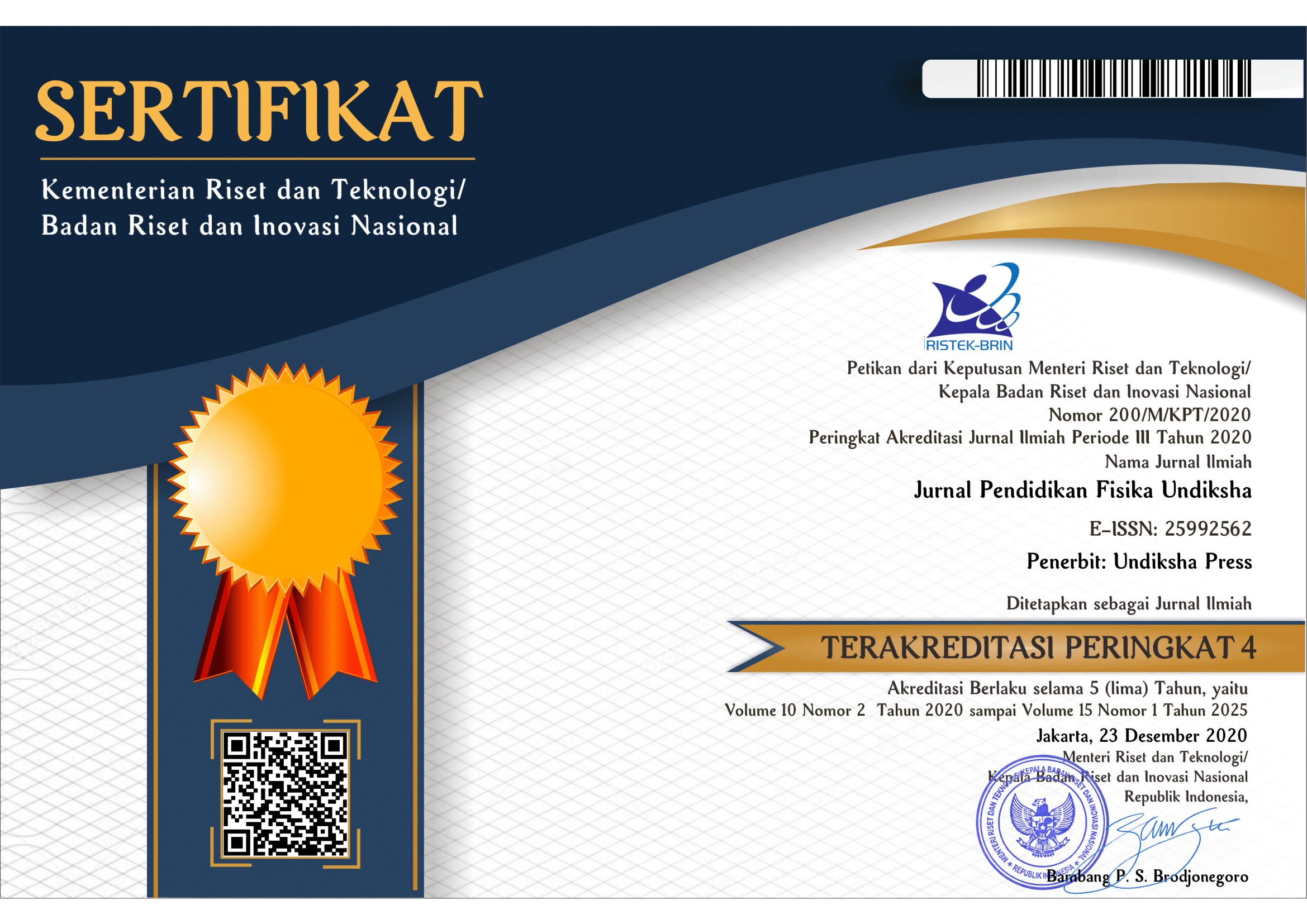PENGARUH STRATEGI PEMBELAJARAN PETA KONSEP SISWA TERHADAP REMEDIASI MISKONSEPSI DALAM PEMBELAJARAN FISIKA
DOI:
https://doi.org/10.23887/jjpf.v1i1.3930Abstract
Penelitian ini bertujuan menganalisis perbedaan remediasi miskonsepsi antara siswa yang belajar dengan strategi pembelajaran peta konsep dan siswa yang belajar dengan strategi pembelajaran konvensional. Penelitian ini menggunakan desain eksperimen kuasi versi faktorial 1×1 pretest-posttest nonequivalent control group design. Populasi penelitian adalah siswa kelas VIII SMP Negeri 1 Sukasada tahun pelajaran 2013/2014. Sampel penelitian terdiri dari dua kelas yang dipilih berdasarkan teknik simple random sampling. Data miskonsepsi dikumpulkan dengan 15 butir tes miskonsepsi. Data dianalisis secara deskriptif dan statistik ANACOVA faktorial 1×1 dengan skor-skor prates sebagai kovariat. Sebagai tindak lanjut ANACOVA, digunakan least significant difference (LSD) untuk menguji komparasi pasangan skor rata-rata remediasi miskonsepsi tiap kelompok perlakuan. Teknik analisis menggunakan program SPSS-PC 20.0 for Windows. Pengujian hipotesis nol dilakukan pada taraf signifikansi 5%. Hasil penelitian menunjukkan bahwa terdapat perbedaan yang remediasi miskonsepsi yang signifikan antara siswa yang belajar dengan strategi pembelajaran peta konsep dan siswa yang belajar dengan strategi pembelajaran konvensional (F = 102,459; p<0,05). Nilai rata-rata remediasi miskonsepsi siswa yang belajar dengan strategi pembelajaran peta konsep (M = 6,19 dan SD = 2,04) lebih tinggi dibandingkan dengan kelompok siswa yang belajar dengan strategi pembelajaran konvensional (M = 2,48 dan SD = 2,39). Siswa yang belajar dengan strategi pembelajaran peta konsep menunjukkan remediasi miskonsepsi yang lebih tinggi dibandingkan dengan siswa yang belajar dengan strategi pembelajaran konvensional.Kata Kunci : remediasi miskonsepsi, strategi pembelajaran konvensional, strategi pembelajaran peta konsep.
The aim of this study was to analyze the difference of misconception remediation between the students who learned by using concept mapping learning strategy and the students who learned by using conventional learning strategy. The research used the quasi experimental of the 1×1 factorial version with pretest-posttest nonequivalent control group design. The population of the research was the eleventh grade of SMPN 1 Sukasada students in the academic year 2013/2014. The samples (two clases) were chosen by simple random sampling. The misconception data were collected by using 15 items of misconception test. To analyze the data, descriptive and ANACOVA statistics of the 1×1 factorial were used where the pretest scores were used as the covariat. For futher analysis to determine the difference of misconception remediation score between the two groups, Least Significant difference (LSD) was used, and the data were analyzed by using the SPSS-PC 20.0 for Windows program. To test the nol hypothesis, the 5% significance level was used. The result of this research shows that there is a significant difference of misconception remediation between students who learn by using concept mapping learning strategy and students who learn by using conventional learning strategy (F = 102.495; p<0.05). Mean score of the misconception remediation of students who learn by using concept mapping learning strategy (M = 6.19 dan SD = 2.04) is better than the students who learn by using conventional learning strategy (M = 2.48 dan SD = 2.39). The misconception remediation of the students who learn by using concept mapping learning strategy is higher than the students who learn by using conventional learning strategy.
keyword : concept mapping learning strategy, conventional learning strategy, misconception remediation.
Published
2014-08-06
Issue
Section
Articles
License

Jurnal Pendidikan Fisika Undiksha is licensed under a Creative Commons Attribution-ShareAlike 4.0 International License.






